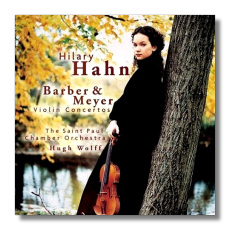
The Internet's Premier Classical Music Source
Related Links
- Barber Reviews
- Latest Reviews
- More Reviews
-
By Composer
-
Collections
DVD & Blu-ray
Books
Concert Reviews
Articles/Interviews
Software
Audio
Search Amazon
Recommended Links
Site News
 CD Review
CD Review
Hilary Hahn

Plays Barber & Meyer
- Edgar Meyer: Violin Concerto
- Samuel Barber: Violin Concerto, Op. 14
Hilary Hahn, Violin
St. Paul Chamber Orchestra/Hugh Wolff
Sony SK89029
My enthusiasm for the Meyer Violin Concerto was not immediate, and my first approach to it was not without reservation. Although Meyer is a classical composer, as well as a bass player, one might not know that from the way Sony has been marketing some things he did with Yo-Yo Ma. It helped me to learn that the germ for the composition came out of a meeting between Hahn and Meyer when they played Bach together. My first acquaintance with the concerto was not love at first hearing, either.
The utterly simple and unabashedly tonal melody which opens the work, though striking, did not strike me as one that would stand up to repeated hearings. (It was to take repeated hearings to convince me I was wrong.) The Barber was not going to be my favorite recording of that piece either, I decided. At any rate, I put the disk aside after a single hearing and took it out again only after attending a Milwaukee Symphony concert at which Hahn performed the Elgar concerto and, as an encore, a dazzling presto by Bach. Hahn has a fine tone, and stood up valiantly to a large orchestra in the Elgar.
So what have I found in repeated hearings of this recording? To get the Barber out of the way first, I still don't think this is ever going to be my favorite version, except perhaps for the headlong finale, which I've never heard played better. There are also a couple of passages in the first two movements which caught my attention. But on the whole this performance strikes me as restrained and maybe a bit facile – the orchestral playing particularly. Since the concerto is one of the most intensely lyrical works ever written, I prefer playing which brings that out fully. Others may find this version more listenable on account of its restraint.
The Meyer is neoclassical in style, progressing from a quiet, simple, perhaps elegiac (Meyer thinks so) theme to greater complexity and considerable force before it is done. In his notes the composer mentions the pull of two tonal centers away from the G# he begins with.
Aside from a hushed passage at the beginning of the second movement, I was not personally aware of much use of harmony but there is effective use of counterpoint throughout the piece, and the solo violin sometimes floats high above a lower accompaniment, strikingly in the case of passages for bassoon and brass.
The range of this music is impressive. In the ten minute opening movement the quiet opening is succeeded by a throbbing, jagged passage for lower voices prior to development of the main theme, which proves strong enough to support traditional development. There is some spritely, angular melody. Early in the second movement there is an almost trill-like passage for winds and lower strings (that's not quite right but I don't know how better to describe these figures), over which the violin stands out. There are two passages in which the soloist has to play a slow melody on one string and a faster theme on another string.
If the composer's notes had not told me this I could not have told you that a second violinist was not involved, however. There are only two movement but the second (16 minutes) includes elements of what could have been called a scherzo (an Appalachian sounding passage – which does not go on too long) and a rousing finale with driving, slashing rhythms. Before the end there is a hushed passage, a brief cadenza and a return of the "Appalachian" theme. Neoclassicism lives!
In her notes, Hilary Hahn calls this work,"a superb and challenging concerto by one of the most original composers writing in the late twentieth century" and a work of "spirit, power, dramatic range, and lyrical beauty." Although one might well question the perspective of one so young, for whom the work was written, I, for one, would not now disagree with her.
Copyright © 2001, 2002, R. James Tobin





















